Surface lab cleanroom paves way for LZ assembly
Collaboration ready to begin work on second-generation dark matter detector.
After years of planning, building and installing systems, Sanford Lab’s cleanroom is, well, really clean, paving the way for the LUX-ZEPLIN collaboration to begin assembling the second-generation dark matter experiment.
“Now that construction is complete and we have done a first round of extensive cleaning of all surfaces, we are taking careful measurements of the degree of cleanliness and radon concentration in the air,” said Simon Fiorucci, a member of the LZ collaboration. “This will take several more weeks until we are convinced of the room's performance. We expect to receive the first LZ detector parts to start assembly by the end of the year.”
At the same time the cleanroom was under construction, Sanford Lab was building a new radon-reduction facility. That building was completed and equipped earlier this summer. Radon, a naturally occurring radioactive gas, significantly increases background noise in sensitive physics projects. The radon reduction system pressurizes, dehumidifies and cools air to minus 60 degrees Celsius before sending it through two columns, each filled with 1600 kg of activated charcoal, which remove the radon. The pressure is released, warmed and humidified before flowing into the cleanroom.
“That’s the magic part of this cleanroom,” said John Keefner, underground operations engineer and project manager for the cleanroom construction.. “The room will be positively pressured so radon can’t get in.”
Creating a clean space for scientists requires more than dust rags and vacuum cleaners. Robyn Varland, custodian for the Davis Campus, and Melissa Barker, a contract custodian from The CleanerZ, worked diligently to remove the visible—and unseen—particles that lingered on the surfaces of the room. The other systems that maintain a clean environment are also in place and functioning; the radon-reduction, water purification and air filtration systems.
“It took about 80 hours to clean and we worked at it hard,” Varland said. “It just takes time, you can’t ‘go clean’ fast.”
Varland uses the same system that is in place for the Majorana Demonstrator cleanroom. In the Surface Lab cleanroom, Varland and Barker spent seven hours just on the grating. “That was the hardest part,” Varland said. “Each bar was vacuumed and washed thoroughly with a wet rag and scrubbing tool to lift the particulates. Spray, wipe with a rag, rinse it out three times.”
And it’s all done moving only half-an-arm-length at a time—all while suited up in cleanroom garb to prevent any contamination.
“Once the initial cleaning happens, you then become the source of dust,” said David Taylor, experiment review engineer for LZ. “That requires special PPE and procedures to keep it clean. Now, the particle counts are really low. That means the dust is gone and it’s ready to use.”

Varland estimated the entire process took roughly 3 to 4 gallons of Simple Green, 1,000 alcohol wipes and 2 gallons of deionized water.
“It’s all about particulates. Even though you can’t see them, imagining them there helps you clean them,” said Varland. “I learned from the best.”
Now, the clean room will need to be maintained in order for LZ to move in. Varland will continue to clean once a week for two hours to keep it maintained and ready for science.
“The new clean room is the first step for LZ to start work at SURF,” Fiorucci said. “It provides not only a clean environment, but also an atmosphere with reduced radon gas concentration, which is critical for control of backgrounds in the LZ detector.”
